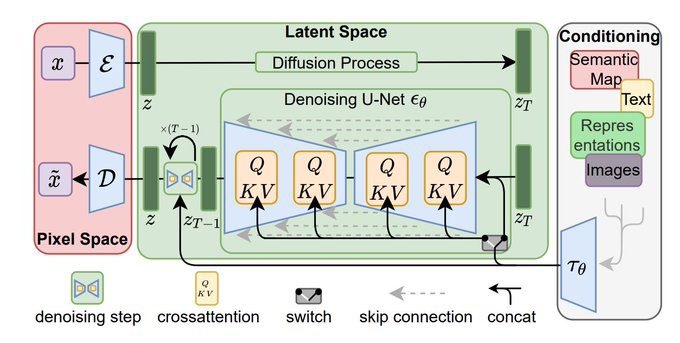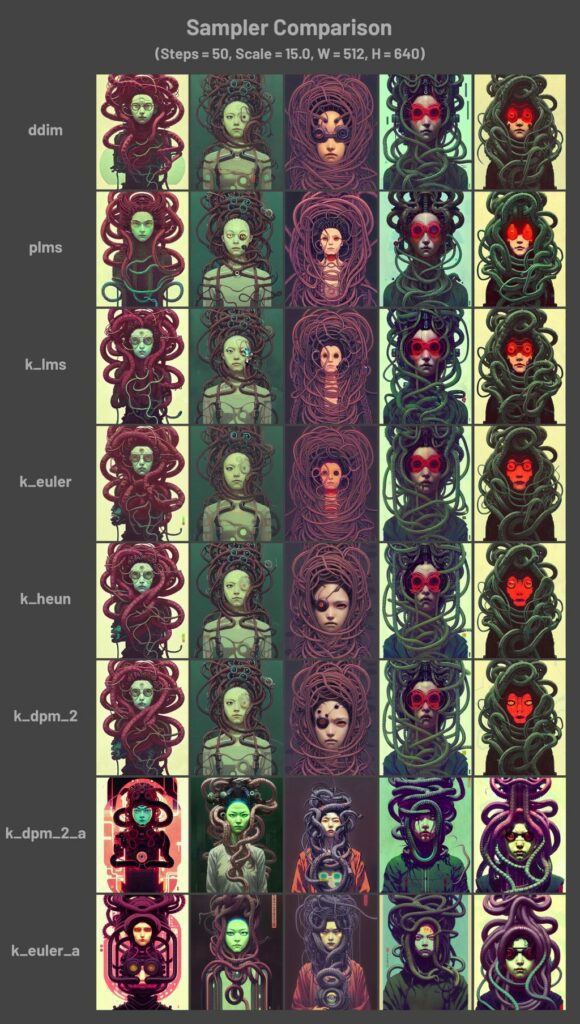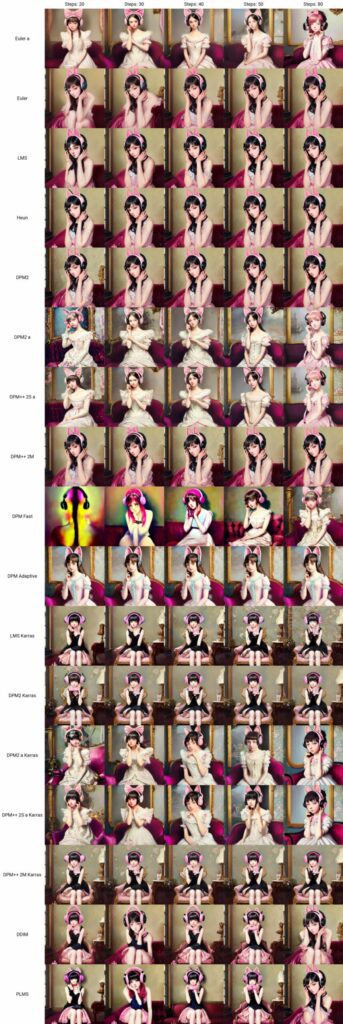What is a Sampler?
Note: We’ve moved the Seed FAQ to its own page
Overview
Samplers are a crucial part of diffusion software. They’re also called Noise Schedulers. Each sampler represents a novel computational way of coming up with an image, meaning there is no wrong answer. That said, switching samplers with the same prompt will produce a slightly different image. Not dramatically different, like switching concepts, but different nonetheless.
If you’re already feeling lost, that’s normal! This is deep AI geek territory.
In fact, it’s perfectly safe to turn around right now and never learn about samplers and still enjoy AI images, as this is typically something that runs in the background without your knowledge, and we set the best one automatically for you in recipes.
But if you’re curious, read on, it’s interesting!
Ancestral? Non-Ancestral?
Samplers help determine the composition of the image. It is the part of the software that decodes the image from pure random noise, guided by the trained model (concept), to bring the image together.
You might notice that some samplers end in A like K_Euler_A. This refers to “Ancestral Processing”, a which is a process of producing samples by first sampling variables which have no parents, then sampling child variables, hence the name. This process has been described as “chaotic” and can produce different results than non-ancestral types, depending on how many steps you choose.
To look up a quick list of samplers in our software, simply type (plural)
/samplers
The supported samplers are returned. The list that looks like this:
ddim, dpm2m, k_euler_a, k_euler, heun, upms
But which one should you pick, and which ones are available?
Recommendations
At this point you’re probably panicking and just want someone to tell you which sampler to use. We get you. But we also have bad news. To make matters worse, samplers react differently to different kinds of images.
Specific to creating people, animated or realistic, it is the sole and unscientific opinion of Morgan in our VIP tech support that these guidelines may help:
| upms | Recommended for most people – best all around. Short for UniPC, it produces excellent results in less steps. |
| dpm2m | Highest quality, but slowest. DPM++ 2M Karras is recommended for anime models, but it is a few seconds slower per image. Worth the wait, imho. |
| k_euler_a | The creative, unpredictable one. This is an ancestral type, meaning it’s going to take a different approach than the others, likely resulting in a very different image. |
| ddim | A good general use sampler. It used to be the fastest before upms. Very reliable, consistent results. |
| k_euler | One of the simplest and thus one of the fastest, but don’t expect many details. A solid choice to build from. |
| heun | Heun is often regarded as an improvement on Euler because it is more accurate, so you’ll get more details but runs twice as slow. |
| klms | We retired this sampler, as it was not performant with higher resolution models at high guidance. RIP. |
EXAMPLE USAGE
/render /sampler:ddim and then your prompt goes here
Tip: You can also type /settings to set your favorite, and it’s always set
The number of steps and which sampler to choose is a hot topic of debate. It’s very subjective, as long prompts can be so different from one another.
When rendering other objects, such as cars and especially complex structures like buildings, this table might send you off in the wrong direction. Please do try them all and let us know your opinions in our Just Chatting group. Do feel free to challenge the advice on this page, as we want to make this page more useful.
Deeper into the rabbit hole
To better understand samplers, you must first understand how the diffusion process works. Think about a blurry image, and how your eye gradually brings it into focus. Computers do the same with diffusion: the general information is stored as noise, literally colorful dots that don’t make sense to the human eye. Consider this image:
A sampler can process that noise and “focus” it into a photo. The sampler comes into play at the denoising step (bottom left)
In other words, Diffusion models learn how to remove noise from images, paired with a description of the image, as a way of learning what images look like, and then to generate new ones.
But how do you go from pure noise to an image *exactly*? There are many answers to this question, and thus, resulting in thousands of different samplers available online. Thousands!
Comparisons
Can’t we just create a chart that compares each one? Remember – it varies greatly by prompt, so any chart we create would be inconclusive: What looks good in one prompt may look worse in a different prompt.
The verdict is not out on that topic, and there is much debate about it online. Here are more comparisons with some unsupported or older ones. The big takeaway here is that you can save time and money by reducing the step count by working with a more “creative” sampler and get similar results.
For this specific prompt — Some samplers can do gentler details than others, like hair, eyes, and so forth… but that same sampler may not be as good for a building. If you have the free time, it’s a super interesting toy to play with. If you are in a hurry, just pick the one you like and add more steps and you can get similar results.
There are tons of comparisons at higher resolutions on google if you want to become a samplers savant. People make really detailed charts!
If you’re feeling exhausted at this point, we feel you.
Just set your sampler to upms and call it a day, it’s very fast and looks great. Or dpm2m if you do anime stuff, as that’s the most frequently recommended by weebs. We’ll keep this page updated as we study them and add more.



